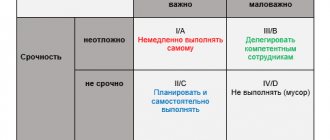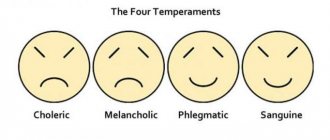Proactive and reactive thinking - what's the difference?
Proactive thinking is the definition of a set of skills. On the one hand, it really relates to thinking, on the other hand, to our attitudes and attitude towards the world around us.
The easiest way to explain the essence of proactivity is from the opposite – it is the opposite of reactive thinking and behavior.
How does reactivity manifest itself? We react to events that happen to us . And we don’t choose our reaction - it is automatic, unconscious. At such moments, we become hostages of circumstances: something happens around us, and we are forced to respond to it somehow, to somehow cope with it.
The opposite of this is proactivity: we pause between the event that happens and our reaction . We choose our reaction, behavior, emotional state. We choose our attitude - through pause.
Choosing your response is one aspect of what is called proactive thinking. The second side is precisely thinking: thinking, planning. These are answers to the questions “What result do I want to achieve?” and “What should I do then?”, “What do I need to change about myself?” and “What should you plan for in advance?”
Proactive thinking is when I predict all possible scenarios and think about how to turn the situation in the direction that I need.
Reactivity in this sense can be explained this way: we live as we live, and when something happens, we already deal with what happened. Although they could have foreseen something and influenced the situation while it was still developing.
To explain in more detail the essence of reactive and proactive thinking, I will give two examples.
Example 1.
Let’s imagine that our colleague (neither a manager nor a subordinate) criticized us quite gently and correctly.
Reactive thinking is the first spontaneous reaction.
Someone will have a desire to challenge what was said: “No, you don’t know all the details, all the nuances, I’ll tell you now how it really is.”
Another option is a sharp feeling of guilt: “Yes, you’re right, I’m bad, I’m a failure.” Total, all-consuming guilt.
The reaction can be aggressive: “You don’t understand anything about this, why are you telling me this?” Or some other, such a first spontaneous reaction.
If we are talking about proactive thinking, this is the following logic of reasoning: “My opinion will always be with me, I can always turn to it. I can imagine myself temporarily packing up my opinions and putting them away in a locker. And now I will try to use my colleague’s words as a very valuable thing and explore what sound grain there may be in them.”
I may wonder why my colleague is telling me about this now, what is happening to him, what emotions I see, how this affects our relationship and the effectiveness of our work together.
I can ask myself the question: “In this situation, what is the most beneficial result for me? How should I be in this situation so that it is useful for me?”
By taking a break, I can choose a behavior strategy. It may be exactly the same reaction that manifested itself spontaneously, or it may be something different.
The key is that this does not happen to me on its own, but I choose how I will treat my colleague’s words in the best way for me. And if I decide that I will have a fight with a colleague, this is my choice, and I understand all the consequences for the business, for the relationship, and for my reputation.
But if I do it just like that, because I don’t know how else to react, and then I reproach myself - this is a completely different situation.
Example 2.
I come to training in a state of reactive thinking and feel like a dissatisfied client. “The materials are not quite on my topic,” “Let’s get closer to my questions,” “The teacher speaks too fast,” “The teacher speaks too slowly.”
I’m not trying to do something here and now, to influence the process - I’m just a passive participant who accumulates discontent. And then I write in the feedback form that everything was wrong, and the cookies and coffee were tasteless, and the teacher could give more practical examples.
If I switch to proactive thinking, I realize that there are things that need to be accepted. There is a teacher with his experience, there is a training program, there are my colleagues. Proactive thinking occurs when I think, “Why am I here?” and “How can I make everything around me serve my goals?”
Then other answers come. Instead of resisting what is happening (“the teacher is theorizing too much”), I can influence the situation: ask a question; approach the teacher during a break and ask for more examples; invite colleagues to share their experiences. I start doing something in the moment. Not to mention, there were things I could have done before the training began to make the process better suit my goals.
This is the main difference between proactive and reactive thinking. In the first case, I am a hostage to the situation, a victim of circumstances. In the second, I clearly understand what I need and take steps to achieve the goal.
Proactive thinking is the search for answers to two questions:
“Where is my zone of influence and what can I do?”
“Where is the concern zone?” – things that I cannot influence.
If I focus my attention on the area of concern - constantly worrying, complaining, getting angry, or even admiring something that is completely out of my control - I waste my intellectual and emotional energy.
And when I understand where my zone of influence is - even if it is very small, but I place it in focus - this is proactive thinking.
The main properties of temperament
According to psychologists, any type of temperament has a number of properties:
- Reactivity. The main property of temperament. Determines a person’s reaction to external influences.
- Sensitivity. This is the force of influence of external factors necessary for the appearance of a mental reaction. For some individuals it is sharp and unexpected. Others remain calm in any circumstances.
- Rigidity, plasticity. Ability to adapt to changing conditions.
- Introversion, extroversion. They influence human behavior in society.
- Excitability. Shows what factors cause emotional arousal.
- Reaction rates. Show the speed of mental reaction to the influence of external stimuli.
In psychological practice, a person’s temperament is assessed for each of the listed properties.
What determines the state of proactivity?
It is influenced by several factors:
General physical condition
It may not be the most obvious, but when we are tired—physically, mentally exhausted—we are more likely to engage in reactive thinking. “Let everything go as it goes, if a problem arises, I’ll sort it out.” The better we feel, the more resource we have for proactive thinking.
Having a desire to develop
If there is a desire to do something, to be interested, to delve into it, to offer solutions, we are more likely to behave proactively.
Our immediate environment
This is a very powerful reason to act reactively or proactively. If our colleagues and friends around us are prone to reactive thinking, we fall under this influence. And we, too, can begin to complain: “Management makes the wrong decisions,” “projects are given rashly,” “the deadlines are unrealistic.” It turns out to be a closed system of complaints and searching for someone to blame.
It’s very difficult to be the black sheep who says at dinner: “Managers may make mistakes, but you and I also have an area of responsibility, we ourselves can offer something.” It can be very difficult to change the general course of a conversation. But we can do this if we feel good and have the energy for it.
If our environment in any situation thinks about what we can influence, what we can take into our own hands, chooses some opportunities for ourselves (maybe not obvious), then we succumb to this influence and begin to think in this way.
Here I will allow myself a recommendation: where we can choose, it is very useful to be around people who already demonstrate proactive thinking. Be with them on work projects, just communicate. Even if we are wondering which podcast to listen to, we can choose one that is hosted by people with this attitude. It is very energizing and nourishing.
We can't always choose. It may turn out that our friend has fallen into a state that the whole world is going somewhere and everything is bad. This, of course, is not a reason to break off relationships, but a reason to balance your environment - try to communicate with those who are in a state of proactivity.
Value management (sketchread)
In this note I present my thoughts on the crisis of traditional management models and ways of transition to management according to...
medium.com
I believe that the fundamental point in describing values is that Value cannot be declared without determining the Price that you are willing to pay for following the value . Here's an example of one large company's value statements:
Safety
- We respect the environment
- We are guided by safe business standards
- We support a culture of safety
- We are personally responsible for safety
Responsibility
- We are honest with each other and partners
- We respect everyone's opinion
- We are responsible for the result
- We value the Company's reputation
Beautiful! But will it work? There is not enough Price to give weight to these words. I believe that the words “even if” can be used. It will turn out:
Safety
- We take care of the environment even if ...
- We are guided by safe business standards even if ...
- We maintain a culture of safety even if ...
- We are personally responsible for safety even if ...
Responsibility
- We are honest with each other and partners even if ...
- We respect everyone's opinion even if ...
- We are responsible for the result even if ...
- We value the Company’s reputation even if ...
Do you feel how the weight of words has changed? It is clear that there may be a struggle over new formulations, but in my opinion this is a sure sign that the definitions are really worth something.
An amazing discovery for me was that the Agile Manifesto proclaims values in precisely this logic, about which I wrote a corresponding note:
How Reactive Thinking Can Harm You
There are no people who always think proactively. We all think and behave differently depending on our state and context. The key is how often we are in reactive thinking. If we are not in a state of proactivity, it can cause harm.
What it will look like externally : if you adhere to reactive thinking, you can end up among events that we did not choose. There is no guarantee that we will like these events. If they happen by themselves, they may not suit us.
The decisions that are made, the tasks that are proposed, the people who appear in our lives and their choices - we will live not what we ourselves chose, but what someone else planned, implemented, and we just happened to be nearby. A significant part of events may not be close to us.
How it will feel from the inside : a state of helplessness, depression, the feeling “I don’t understand why I go to work,” “I don’t understand what these people are doing next to me,” “I don’t influence anything.” This is a very low quality of life - when there is no feeling of joy, there is only a feeling of emptiness. This is a pretty significant flaw in reactive thinking.
We can be very lucky: we didn’t choose anything ourselves, all events fell upon us, and they are all pleasant. Such a scenario may exist, but it is not very realistic.
In the next post we will tell you how you can develop proactive thinking.
Phenomena -> Situation Model
It is human nature to look for meaning in everything, discover relationships between phenomena, and build explanatory models. It is thanks to models that we can predict the future.
And if for the physical world the models work quite accurately, since the factor of will does not interfere with their work, then for social systems the situation is not so clear. However, understanding certain social laws, if it does not allow one to predict the outcome of a particular event, does allow one to see a trend.
For example, the law of diminishing marginal utility says that you can’t last long on one innovation, you need to create a flow of innovations.
In accelerators, newly minted startupers are taught to think about their business through the prism of Alex Osterwalder’s business model canvas. Business schools study SWOT analysis, the Boston Consulting Group matrix, 7s McKinsey, AIDA and others.
The more extensive your arsenal of models, the more ways you have to think. The invention of a new model is always a breakthrough precisely because it opens up the opportunity to think about reality in a new way.
Here's an example: the famous consultant Isaac Adizes invented the PAEI model of management styles and, thanks to it, explained why ideal managers do not exist, but an ideal team of managers is possible.
Where do new models come from? It's simple. Existing models need to be problematized and then rethought. This will require detecting phenomena that do not fit into existing models.
For example, the ancient Greeks realized that the earth was round by looking into wells and discovering that in some cities the sun illuminated the bottom at its zenith, but in others it did not. This surprising fact problematized the flat earth model, since the Sun at its zenith on a flat earth should illuminate the bottom of all wells.
The heliocentric system was coined as a result of the problematization of the complex system of celestial spheres created by Ptolemy.
Einstein came up with the theory of relativity when Newton's theory was problematized by the fact that the observed parameters of Mercury's orbital motion did not correspond to the calculated ones, and Eddington confirmed the presence of a gravitational lens created experimentally by the Sun.
The agile approach to software development emerged from the problematization of the waterfall model.
Managing insight is the second key to proactive thinking. Basic thinking operations for working with models: comprehension, problematization, rethinking.
Let me put it bluntly: without building or using models, there is no proactive thinking.








